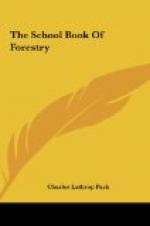The stealing of soil by erosion occurs where run-off waters are not obstructed by forest growth. Silt, sand, and every other kind of soil are swept from their natural positions and spritted away by the foaming waters as they surge down the steep slopes. The stream or river which is flooded by these rushing waters roars down its narrow channel, tearing loose and undermining the jutting banks. In some cases, it will break from its ordinary course to flood exposed fields and to carry away more soil. As the speed of the stream increases its power to steal soil and carry it off is increased. Engineers report that the carrying power of a stream is increased 64 times when its rate of flow is doubled. If the flow of a river is speeded up ten times, this raging torrent will be able to carry one million times as much foreign material as it did when it was flowing at a normal rate of speed, causing inexpressible damage and destruction of life and property.
The protection afforded by forests on the water-sheds of streams furnishing the domestic water supply for cities and towns is becoming more fully realized. A large number of cities and towns have purchased and are maintaining municipal or communal forests for this very reason.
CHAPTER IV
WILD LIFE OF THE FOREST
The forests of our country are the home and breeding grounds of hundreds of millions of birds and game animals, which the forests provide with food and shelter. If we had no forests, many of these birds and animals would soon disappear. The acorns and other nuts that the squirrels live upon are examples of the food that the forest provides for its residents.
In the clear, cold streams of the forests there are many different kinds of fish. If the forests were destroyed by cutting or fire many of the brooks and rivers would either dry up or the water would become so low that thousands of fish would die.
The most abundant game animals of forest regions are deer, elk, antelope and moose. Partridge, grouse, quail, wild turkeys and other game birds are plentiful in some regions. The best known of all the inhabitants of the woods are the squirrels. The presence of these many birds and animals adds greatly to the attractiveness of the forest.
Predatory animals, such as wolves, bears, mountain lions, coyotes and bobcats also live in the forest. They kill much livestock each year in the mountain regions of the Western States and they also prey on some species of bird life. The Federal and some State governments now employ professional hunters to trap and shoot these marauders. Each year the hunters kill thousands of predatory animals, thus saving the farmers and cattle and sheep owners many thousands of dollars.




